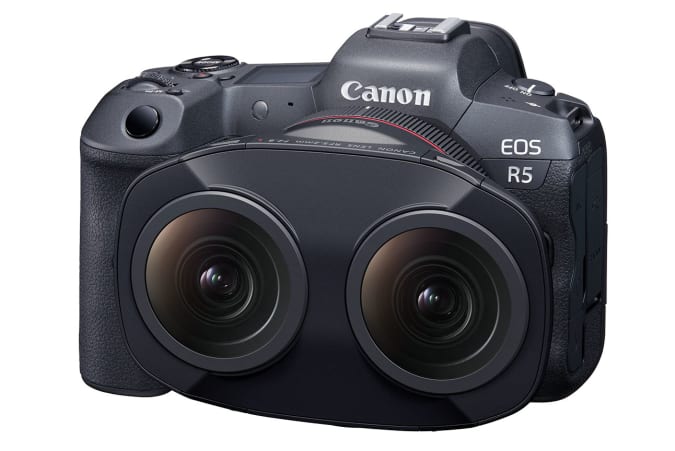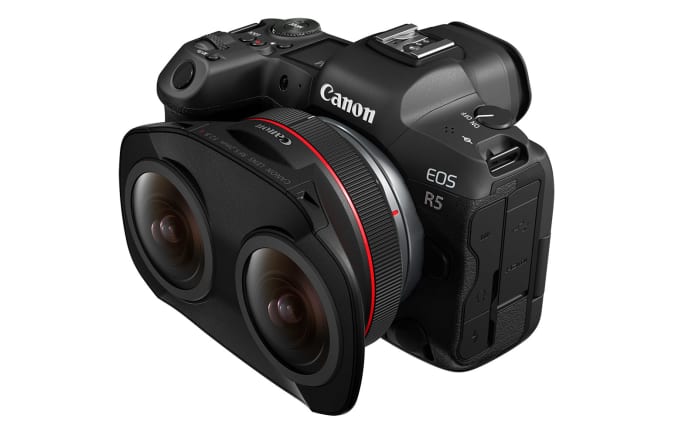Canon created a dual fisheye lens for a new VR video system
Canon has made a surprising product announcement, revealing a dual, RF mount fisheye lens that’s part of an all-new system called EOS VR. Its aim is nothing less than to transform VR and AR production by making workflow simpler than current systems, while delivering the quality of a full-frame mirrorless camera.
The key product is the $1,999 RF5.2mm F2.8 L Dual Fisheye manual lens designed specifically to mount on Canon’s 8K-capable EOS R5 camera. It’s a highly unusual looking product, to say the least, with two bulging fisheye lenses mounted side by side. They’re placed approximately 60mm (24 inches) apart to match human interpupillary distance and provide comfortable parallax for VR and AR.
The lenses project two circular images onto the EOS R5’s 45-megapixel sensor. They support 190-degree capture, allowing for delivery of stereoscopic 180-degree 3D footage or photos at up to 8,192 x 4,096 resolution for AR or VR applications.
Canon
The lens has some unusual features, like a ring that focuses both lenses at once and an Allen screw adjustment that lets you tweak the focus of one lens to precisely match the other. Otherwise, you get features typically found in high-end Canon L RF mount glass, like coatings to control flare and ghosting, dust and water-resistant sealing and a solid F2.8 to F16 aperture range. Despite the odd looks, the lens is fairly compact and not much larger than Canon’s 35mm F1.8 lens.
The lens is just one part of the equation, though. Canon is working on a firmware update for the R5 with new features to support the lens and EOS VR system. That includes MF peaking and manual focus confirm via Canon’s Dual Pixel autofocus system, along with a “Magic Window” UI that helps user plan for delivery to different types of headsets.
In addition, Canon made its own EOS VR Utility and EOS VR Plugin apps, each available by subscription for $5 per month. The VR Utility app flips the stereo images left to right and converts them from circular to an “equirectangular” square image that can be viewed on a VR headset. It also offers quick editing tools like trimming of clips and application of a LUT, while letting you change to preset resolutions and file types (DPX, Pro Res, H264, etc.) prior to export.

Canon
There’s also the EOS VR plug-in for Adobe Premiere that “will convert the dual fisheye imagery to equirectangular, while allowing the ability to cut, color, and edit with the full control of Premiere Pro,” Canon told Engadget. It also lets you export footage to the desired spec for different types of delivery.
The system can be used for weddings, journalism, sports, training, events and more, while offering a number of advantages over current VR cameras. To start with, it’s designed to deliver quality superior to standalone VR cameras with smaller lenses and sensors like the $5,000 Insta360 Pro 2. At the same time, you get all the R5’s tools like log shooting, RAW capture, 10-bit video and more. And when you’re not using the VR lens, the R5 can be used for regular video production or photo shoots, unlike dedicated VR cameras.
At the same, the production process is simpler and cheaper than with dual cameras used in higher-end productions. Those cameras must be rigged, synced, focused and positioned correctly, with the end result being two files in many cases. Canon’s EOS VR system, by contrast, delivers similar quality but offers focus and setup like a regular camera, while leaving you with a single file to edit at the end.

Canon
The entire system isn’t exactly cheap, considering you need to pay $1,999 for the lens and $3,899 if you don’t already have an R5 camera, for a total of $5,898. However, considering how niche the lens is, it costs less than I expected. There’s also the issue of R5 overheating that limits 8K recording times to 20 minutes, with a 10-minute recovery period. You can improve that by capturing 8K to an external Ninja V+ RAW recorder, but that’ll add $1,500 to your cost.
Still, it looks very promising for VR, which has boomed in popularity during the COVID-19 pandemic. It’s been especially in-demand for business training and collaboration, which in turn requires content production. A lot of producers, particularly those who already have a Canon EOS R5, might be willing to jump into that type of work if Canon’s new system is as easy to use as it promises.
All products recommended by Engadget are selected by our editorial team, independent of our parent company. Some of our stories include affiliate links. If you buy something through one of these links, we may earn an affiliate commission.
For all the latest Technology News Click Here
For the latest news and updates, follow us on Google News.
